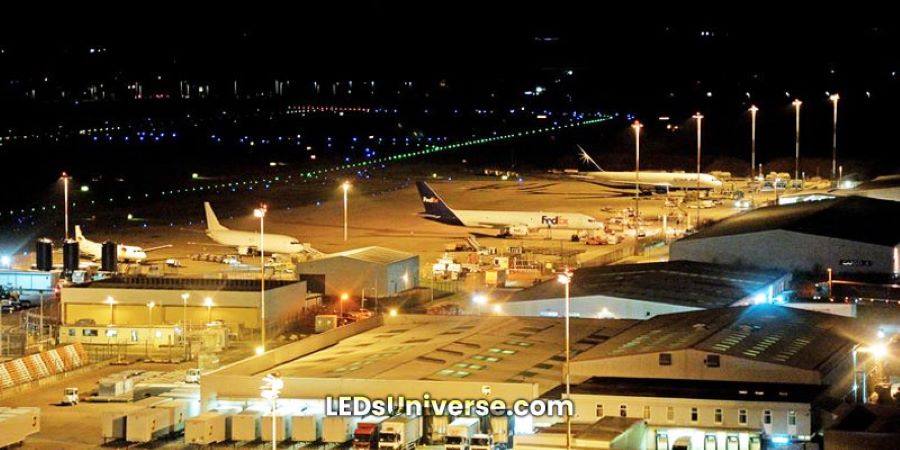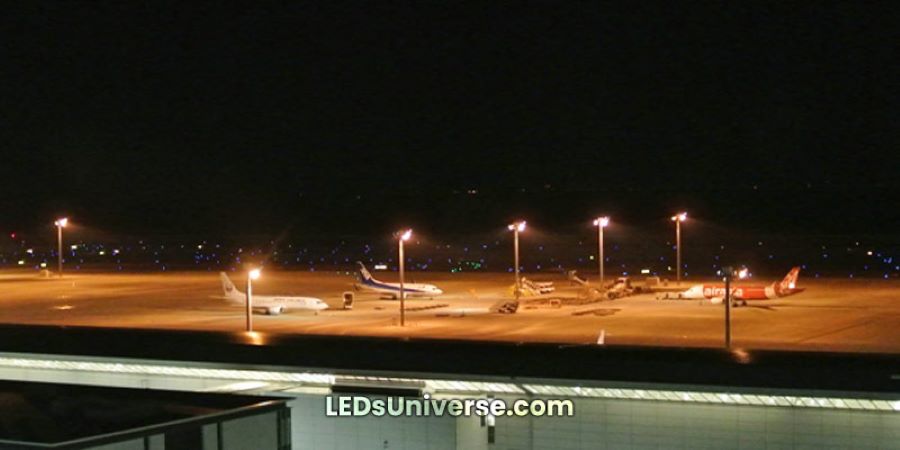From guiding planes as they taxi to illuminating critical work areas, the right lighting systems make it possible for pilots and ground crews to operate seamlessly, even in the most challenging weather or nighttime conditions. With a variety of specialized lights designed for different functions, apron lighting not only helps to navigate but also enhances the overall coordination of airport traffic. Let’s explore the essential types of apron lighting and their roles in ensuring smooth airport operations.
Proper lighting on the apron enhances visibility for both aircraft and ground vehicles, minimizing the risk of accidents or collisions. It also ensures that pilots and ground personnel can clearly distinguish apron boundaries, taxiways, and adjacent areas, improving both safety and efficiency.
Reach out for free lighting consultation
Table of Contents
ToggleOne of the primary functions of apron lighting is to ensure the safety of aircraft, ground vehicles, and personnel operating in and around the apron. Clear, consistent illumination helps prevent accidents by making the boundaries of the apron visible, highlighting taxiways, and providing sufficient light for loading, unloading, refueling, and other essential ground services. Without adequate lighting, the likelihood of collisions or mishaps increases, especially during nighttime or adverse weather conditions.
Enhanced visibility is crucial for aircraft maneuvering on the ground and for ground vehicles conducting daily operations. Apron lighting ensures that even during periods of low visibility, whether caused by fog, rain, or darkness, personnel can safely navigate the space. The lights improve situational awareness, enabling better coordination between pilots, air traffic control, and ground staff.
Apron lighting also serves as a guiding tool, directing aircraft and ground vehicles to their designated positions on the apron. For instance, it helps pilots navigate their aircraft to gates or maintenance areas, reducing confusion and promoting smoother operations. The use of lights that signal specific positions allows for more precise movements, which improves operational efficiency.
Besides offering visibility and safety, apron lighting can also serve as a form of communication. Lights on the apron can relay critical information to pilots and ground personnel, such as indicating the status of an aircraft, the availability of a gate, or signaling that certain areas are off-limits. This communication function is essential for managing complex airport operations smoothly.

The design and installation of apron lighting must adhere to stringent aviation regulations, typically outlined by bodies such as the International Civil Aviation Organization (ICAO) and the Federal Aviation Administration (FAA). These standards specify the lux levels required for adequate illumination, the type and placement of lights, and other technical requirements to ensure safety. Airports need to ensure that their lighting complies with these guidelines to provide a safe operational environment.
Proper illumination levels on the apron are vital for the safe execution of ground operations. Lux refers to the intensity of light over a given area, and apron lighting must provide a sufficient lux level to ensure that all activities are clearly visible. Uniformity is another critical factor, as uneven lighting can cause shadows and dark spots, creating hazards for both personnel and equipment.
Glare can be a significant issue in airport lighting, as it may impair the vision of both pilots and ground personnel. Apron lighting systems must be designed to minimize glare, particularly in areas where pilots need clear visibility of the taxiways and gates. Specialized low-glare fixtures help achieve this balance by providing sufficient light without creating visual obstructions.

The strategic placement of lights is key to ensuring that the apron is evenly lit without causing obstructions. Lighting fixtures are typically mounted on high poles to provide broad coverage. The height of these poles must be carefully considered so that they do not interfere with aircraft wings or other ground equipment. Additionally, pole placement should avoid creating shadows or blind spots, especially in areas where visibility is critical.
The beam angles of the lights are equally important in determining how well the apron is illuminated. Lights need to be angled in a way that ensures even distribution of light across the apron without creating sharp contrasts between light and dark areas. Careful planning of light distribution helps in achieving uniform brightness, which is necessary for the safe navigation of both aircraft and ground vehicles.
Airports are often exposed to harsh environmental conditions, including rain, wind, snow, and extreme temperatures. The lighting fixtures used in apron lighting must be durable enough to withstand these elements. Weather-resistant materials such as corrosion-resistant metals and tempered glass help prolong the life of the lights, reducing maintenance costs and ensuring continuous operation.
Taxiway edge lights are essential components of apron lighting, designed to mark the edges of taxiways and provide pilots with clear, visual boundaries during both day and night operations. These lights are strategically installed along the edges of taxiways at regular intervals, creating a continuous line that guides aircraft as they move between the apron and the runway. Taxiway edge lights are often blue and are crucial in maintaining safe navigation, especially during periods of low visibility, such as fog, rain, or nighttime operations.
Within the category of taxiway edge lights, there are variations that serve specific functions. For instance, centerline lights are installed along the center of taxiways, providing additional guidance to pilots to ensure their aircraft remain on course. Touchdown zone lights, typically white, are placed near the runway to indicate the safest zone for aircraft to touch down. These variations in lighting help enhance the overall safety and efficiency of airport operations by providing pilots with clear, unambiguous visual cues as they maneuver their aircraft on the ground.
Hold position lights are another critical element in apron lighting systems, playing a vital role in managing ground traffic at airports. These lights are used to indicate the precise location where an aircraft must stop before entering an active runway. The use of hold position lights is essential for preventing runway incursions, where two or more aircraft inadvertently occupy the same runway space, which could lead to severe accidents.
Hold position lights are typically red, a color chosen for its high visibility and universal association with the concept of stopping or halting. Positioned at various points along taxiways, these lights ensure that aircraft do not proceed onto the runway without proper clearance from air traffic control. The presence of hold position lights is crucial in maintaining the safe and orderly flow of ground traffic, particularly at busy airports where multiple aircraft may be moving simultaneously.
Lead-on and stop bar lights are specialized lighting systems that further enhance the safety and efficiency of airport apron operations. Lead-on lights are typically green and are used to guide aircraft from the taxiway onto the runway. These lights help pilots align their aircraft correctly as they prepare for takeoff, ensuring a smooth transition from taxiing to accelerating down the runway.
Stop bar lights, on the other hand, are red and are installed at points where aircraft must come to a complete stop before proceeding onto an active runway. These lights are typically used in conjunction with air traffic control instructions to manage the flow of aircraft, ensuring that only one aircraft is on the runway at any given time. Stop bar lights are particularly important at airports with high traffic volumes, as they help prevent runway incursions and ensure that aircraft movements are coordinated safely.
The combination of lead-on and stop bar lights is essential for maintaining a smooth, orderly flow of ground traffic at airports. These lighting systems work together to guide aircraft safely onto runways and prevent unauthorized or unsafe movements that could lead to accidents.
Apron floodlights are perhaps the most prominent and powerful lights in the apron lighting system, designed to provide broad, uniform illumination across large areas of the airport apron. These lights are typically mounted on tall poles or other elevated structures, allowing them to cast light over vast expanses of the apron where aircraft are parked, loaded, unloaded, refueled, or serviced.
The primary function of apron floodlights is to ensure that all activities on the apron can be conducted safely and efficiently, even during nighttime operations or in poor weather conditions. By providing consistent and bright illumination, these lights help ground personnel, pilots, and vehicle operators see clearly, reducing the risk of accidents and ensuring that all apron operations are carried out smoothly.
In addition to enhancing safety, apron floodlights also play a role in improving security on the apron. Well-lit areas are less vulnerable to unauthorized access or activities, as the lighting acts as a deterrent to potential intruders. The use of modern, energy-efficient floodlights, such as LED technology, further enhances the effectiveness of apron floodlighting by providing brighter light while consuming less energy, contributing to the overall sustainability of airport operations.
LED lighting has become the standard for modern apron lighting systems due to its energy efficiency and long lifespan. LEDs consume significantly less electricity than traditional lighting systems, reducing the operational costs for airports. Furthermore, they produce less heat and have a longer life cycle, which cuts down on the need for frequent replacements.
Airports are increasingly adopting sustainable apron lighting solutions to minimize their carbon footprint. Solar-powered lights, for instance, can be used in certain airport locations to reduce reliance on the electrical grid. Smart lighting systems that adjust the intensity of the lights based on the time of day or traffic flow can also contribute to energy savings.
Regular maintenance is crucial to ensure that apron lighting systems remain functional and effective. Routine inspections help identify issues such as burned-out bulbs or damaged fixtures that could compromise the safety of airport operations. When problems are detected, repairs should be carried out promptly to avoid disruptions.
Preventative maintenance includes tasks such as cleaning lights to remove dirt and debris, lubricating moving parts, and replacing bulbs before they burn out. Airports that implement robust preventative maintenance programs typically experience fewer unplanned outages and reduced long-term maintenance costs.
Adhering to regulatory standards, maintaining appropriate lux levels, minimizing glare, and strategically placing lights are crucial for effective apron lighting. Advances in technology, such as LED and sustainable solutions, further enhance energy efficiency and operational effectiveness. Regular maintenance ensures that these lighting systems remain reliable and efficient, contributing to a safer and more efficient airport environment.